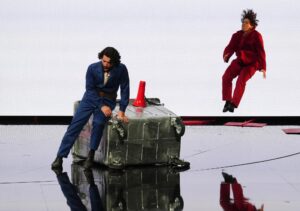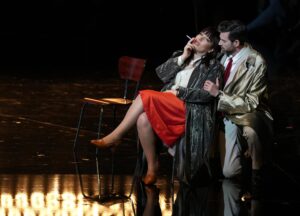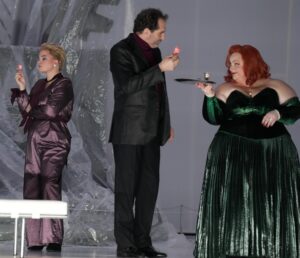In mid-May 1968, two days after the occupation of the Sorbonne and the general strike in France began, Jean-Louis Barrault opened the doors of the Odéon to a crowd of several thousand demonstrators. He did not suspect that the events of the 1830 July Revolution, when the theatre became one of the main centres of activity for the rebellious youth of the day, would be repeated in a distorted form and get out of hand. The first barricades made of cars, fallen trees and furniture hauled from the university were already standing in the Latin Quarter. The red banners of the socialists and the black flags of the anarchists flew in the streets, tear gas fumes were in the air. The protesting students ripped the lids off the city’s rubbish bins to use them as shields in clashes with the police. They were joined by artists, intellectuals and a growing number of agitators. On the night of 16-17 May Barrault noted in his diary: “We feel betrayed and have no desire to take sides. We are moved only by genuine students. It seems to me that they have been betrayed as much as we have”.
The revolt in Italy began much earlier and lasted much longer, from 1966 until the autumn of 1969. It swept through universities all over the country, from Milan and Turin, Naples and Padua, to Genoa and Salerno. Unlike in France, in Italy the student movement merged from the very beginning with the workers’ movement. The students helped the strikers edit leaflets, and held joint meetings to analyse the course of events and plan strategies for the future. The government focused primarily on torpedoing the activities of the extreme left. It ignored extremists on the other side, including the radical, neo-fascist faction of the Ordine Nuovo. In December 1969 two members of the organisation carried out a bomb attack in Milan’s Piazza Fontana. Seventeen people were killed. The “creeping May” ended and the “years of lead” began.
One hundred and twenty years earlier, in 1848, when the riots later referred to as “Cinque giornate” broke out in Milan, Verdi happened to be in Paris. Hearing about the uprising, he set out for Lombardy and arrived there on 5 April, two weeks after the end of the uprising. In a letter to Francesco Piave he announced that he was drunk with happiness after the rebels’ victory and did not intend to waste paper on composing, when it would be better to use it to make casings for bullets. It was a Pyrrhic victory. The losses suffered by Milanese were twice as big as those of the Austrians they chased away; and the Austrians returned to the city in July. The Risorgimento lasted until 1871 and did not end with the unification of all the lands inhabited by Italians. The year 1968 changed the face of the world, but it is still only one of the many milestones on the path to a united Europe that is yet to be travelled.
Rivoluzione. Enea Scala (Carlo). Photo: Karl Forster
Jacques Mallet du Pan was a royalist, but he rightly compared a revolution to Saturn devouring his own children. Krystian Lada followed this clue in his latest project, commissioned by Brussels’ La Monnaie and its boss Peter de Caluwe. This was the second attempt by the company – after the well-received Bastarda based on a concept by Olivier Fredj – to revive the Baroque pasticcio convention. However, while the idea behind the Bastarda was to extract the Queen Elizabeth thread from Donizetti’s four operas and glue their fragments together into a new, though still “Tudor”, whole, Lada went much further, creating a true pasticcio: an entirely new story based on musical material from Verdi’s sixteen operas, written during the initial stage of the struggle for the unification of Italy. The first part of the diptych, Rivoluzione, is set during the tumultuous 1968 riots, the second, Nostalgia – forty years later, when memories of the revolution are revived at a vernissage, under the impact of a sculptural installation drawing on those events.
A crazy idea, requiring painstaking dramaturgical work and a meticulous selection of fragments to match the concept (fragments taken from Oberto, Ernani, Stiffelio, I Lombardi alla prima crociata, Attila, I due Foscari, Giovanna d’Arco and Un giorno di regno, as well as from Nabucco and Macbeth, among others), and yet it turned out to be successful and, paradoxically, in many ways truly “Verdian” in spirit. If purists missed anything, it was a musical binder composed specifically for the occasion, which would have given both parts the semblance of a “genuine” nineteenth-century opera. Lada, however, opted for a different approach, stitching the various elements together with film inserts featuring the singers in spoken interactions and monologues, and thus avoided a “contamination” of Verdi’s music with any foreign musical body. And he probably did the right thing: the mosaic nature of the theatrical means used fitted much better with the narrative he devised, divided as it was by a distance of forty years, but still set in a not-so-distant past.
In Rivoluzione the action rushes forward like a crowd of enraged demonstrators. Lada plays out the crowd scenes brilliantly, weaves into the action excerpts from documentary films from the period, and enhances the message of the arias, cabalettas and ensembles thanks to the participation of street dancers (excellent choreography by Michiel Vandevelde). In the as usual clean stage space (the author of the entire concept was Lada, assisted in the making of the sets and video material by Łukasz Misztal and Jérémy Adonis, respectively; the costumes were designed by Adrian Stapf), superbly lit by Aleksander Prowaliński, a thread of truly Verdian intrigue is spun. The crucial character is the shipbuilder Carlo, a friend of Giuseppe, an engineering student and son of an influential police officer. Their “class inappropriate” relationship arises from their shared love of boxing. Giuseppe is dating Cristina, a film school student who still finds it impossible to recover from her old love for Carlo. Laura, Giuseppe’s sister, a violin student in a relationship with the pianist Lorenzo, who is head over heels in love with her, succumbs to a growing fascination with the devilishly handsome Carlo and abandons bourgeois ideals for the slogans of the revolt. Everything is heading for a dramatic finale on the barricades: Laura commits suicide and by the decision of the crowd joins the Pantheon of the great martyrs of the revolution.
Rivoluzione. Nino Machaidze (Laura) and Vittorio Prato (Giuseppe). Photo: Karl Forster
The story could have taken place anywhere in Europe at the time: in Paris, Milan, tank-wrecked Prague or Warsaw during the March 1968 events. Lada’s sources of inspiration might perhaps be found in Bertolucci’s The Dreamers or films by the French New Wave directors. Yet they can be more easily discovered in Verdi’s early operas, in which the “music of guns and cannons” is heard constantly, while youthful ideals clash with outbursts of equally youthful feelings in complicated amorous polygons. Lada used the potential of the Verdian convention to the full. He entrusted Laura with parts intended for a soprano with dramatic overtones, and Cristina – with parts suitable for a singer faithful to the tradition of the Italian bel canto of the likes of Donizetti and Bellini. The charismatic Carlo is a typical Verdi tenor, Giuseppe, an ambiguous character, is, appropriately, a baritone. Lorenzo’s anger and unrequited feelings are conveyed by a bass voice.
Lada “breaks” this convention with extraordinary sensitivity in Nostalgia, which takes place forty years later. Cristina is gone. Her daughter Virginia has inherited her late mother’s love of film art, subtle beauty and no less subtle voice (Lada cast the same singer in the role). The protagonists have aged. Carlo is a baritone, Giuseppe a bass and Lorenzo stops singing altogether (the bass is replaced with the actor Denis Rudge). Icilio, a politically engaged artist, sings with a tenor in which we can hear a distant echo of young Carlo’s voice. Enter Donatella, an art gallery owner, who organises a double vernissage of Virginia’s film and her boyfriend Icilio’s sculpture, entitled “Barricade 1968”. This archetypal Verdi prima donna will provoke a catharsis on the scale of an ancient tragedy in the finale: she will accidentally make Virginia realise who her father really is, summon the spirit of Laura from the beyond, unleash dormant energy in three old men, order them to destroy Icilio’s work and chase away the demons of the revolution that devoured everything they once loved.
There are several very memorable images in this diptych: a girl’s naïve delight at the sight of an atomic mushroom cloud, a delight stifled a moment later by the immense sadness of the “Patria opressa” chorus from Macbeth; the finale of the third act of Rivoluzione, binging to mind ghastly associations with Géricault’s Raft of the Medusa and several paintings by Delacroix; and the symbolic ending of Nostalgia, in which Lorenzo tries to rescue a plaster bust of Verdi from an orgy of destruction. This was another encounter for me with ultra-modern opera theatre, precisely directed, intricately put together from a myriad of perfectly fitting pieces, but, at the same time, drawing on the composer’s legacy with a fidelity bordering on homage.
Huge credit for this goes to all the musicians involved in the project, above all to the conductor Carlo Goldstein, who combines an admirable knowledge of the Verdian idiom with a sensual fervour of interpretation. Laura was finely portrayed by Nino Machaidze, singing with an impeccably produced soprano that was powerful and perfectly developed in the upper range, although not very resonant in the middle. Endowed with a luscious and tireless tenor, perfect for the role of Carlo in Rivoluzione, Enea Scala could have varied the dynamics a bit more, but I will put this minor shortcoming down to his enthusiasm, which enabled him to build a more convincing character of the young rebel. Scott Hendricks, his older incarnation in Nostalgia, has a fairly small and rather gravelly baritone, which in the second part of the diptych should, paradoxically, be regarded as an asset. The two performers of the role of Giuseppe, the baritone Vittorio Prato and the bass Giovanni Battista Parodi, did a great job. I admire the expressive power of Justin Hopkins’ interpretation (of Lorenzo), although his dark, velvety bass would definitely have benefitted in terms of beauty of tone, had the artist not been prone to singing with a low larynx. Paride Cataldo, an artist with a resonant and richly coloured lyric tenor, did well in the small role of Icilio.
Nostalgia. Gabriela Legun (Virginia), Giovanni Battista Parodi (Giuseppe), and Helena Dix (Donatella). Photo: Karl Forster
As usual, I have saved the best for last. The sensation of the diptych was Gabriela Legun in the dual role of Cristina and Virginia. Legun is a phenomenally gifted Polish soprano, winner of the 2019 Ada Sari Competition, who I think will have a beautiful international career. Legun’s golden, soft voice already impresses with its impeccable technique, and if her interpretations are still “transparent” at times, they will certainly become more expressive as she accumulates more stage experience. The other jewel in the vocal crown of Rivoluzione e Nostalgia was undoubtedly Helena Dix (Donatella), a singer endowed with a supple, sensuous, truly Verdian soprano, which she wields with enough awareness to turn Lady Macbeth’s great madness scene into both a dazzling display of bel canto and a perverse parody of the convention associated with the role. In today’s opera houses it is rare to find such an great combination of superb singing and outstanding acting with an unparalleled sense of humour.
Jean-Louis Barrault wrote shortly after the events of May 1968 that the streets of Paris were seized by hatred, that people would not be able to realise the momentousness and consequences of those events for a long time. I think the time has come. Krystian Lada and the co-authors of the success of his Brussels diptych began to dig out from under that hatred the first crumbs of love – the one that died, the one that was revived years later and the one that will last forever. As in Verdi’s music, which turned out to be a perfect vehicle for a story about quite different times.
Translated by: Anna Kijak



